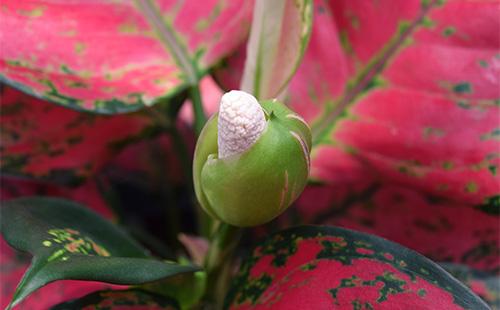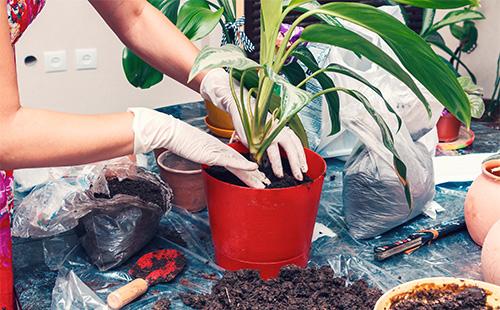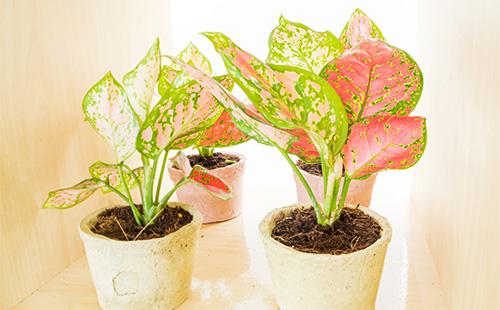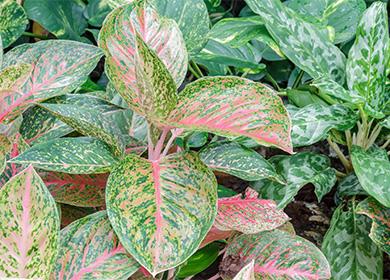The content of the article
Beautiful Indiana is a rather unpretentious plant. It will become the real pride of a beginner grower. Aglaonema is undemanding to lighting and will easily put up with partial shade. The flower practically does not cause trouble and rarely gets sick. Combining various types of aglaon in the interior, you can create an original floral arrangement and even green the dark corners of the apartment.
Acquaintance with the main types
A herbaceous plant, perennial, is a native of the tropical rainforests of East India, the islands of the Malaysian archipelago. Aglaonema is a lover of a humid climate, therefore in the wild he lives on the coast, can be found in the shadow of deciduous thickets.
general characteristics
In appearance, the flower is a bit like its relative, Dieffenbachia. But unlike her, usually does not exceed 70 cm and has a thick fleshy stalk. This trunk is noticeable exclusively in adult flowers. In young plants, the stem branches at the base.
Aglaonema has long beautiful leaves. Depending on the variety, they are monophonic or contain light inclusions. Some aglaonemes, as shown by reviews, can hit with a unique emerald color or multi-colored mottled strokes.
Room representatives
There are more than 50 types of aglaonem. Moreover, not everyone can boast of natural origin. The plant aroused great interest among breeders. Thanks to this, new varieties with a unique color were born. In indoor floriculture, only a few varieties are common, which are collected in a table.
Table - Types and description of aglaonem for indoor cultivation
| Name | a brief description of |
|---|---|
| Tall species | |
| Silver bay | - Barrel more than 1 m; - for a long time remains a lush bush; - Leaves are pointed (about 30 cm), with gray spots; - with age, the bright color of the plant transforms into dark; - culture is cold resistant |
| Friedman | - grows to 150 cm; - large leaves with a wavy edge; - silvery spots in the middle of the leaf, and saturated green blotches on the edges |
| Pattaya Beauty | - Slender thin stems; - leaves with green edges and a bright middle; - able to grow in the shade; - withstands temperature extremes; - put up with low humidity |
| Mid-sized species | |
| Silver Queen | - Reaches 40 cm; - leaf color from silver to light blue; - needs good lighting |
| Modest | - It grows in height by half a meter; - rounded leaves end with sharp tips; - on the leaves there are convex veins |
| Maria | - The bush grows to 30-40cm; - the leaves are thick, dark green; - makes a shadow; - able to grow under artificial lighting |
| Undersized species | |
| Rounded | - Height is about 25 cm; - leaves are heart-shaped, e red-black color; - pink stripes are drawn on the leaves |
| Ribbed | - Branching creeping trunk; - leaves are heart-shaped green or white with various inclusions, strokes; - blooms a couple of days before the New Year |
| Short cover | - It has elongated oval-shaped leaves; - in the center of the sheet is a white vein; - to get an ornamental shrub, three to four seedlings are planted in one pot |
Proper Aglaonema Care
The plant grows very slowly and does not cause much trouble. However, remember the toxicity of aglaonema juice. Therefore, experts recommend putting it out of the reach of children and animals. It is not recommended to settle a dangerous Indian woman in a bedroom or a recreation area. The aglaonema will bring invaluable benefits in the living room, conservatory, in large offices or halls, in which air purification from harmful components and bacteria is simply necessary.
How to care for aglaonema? Florists are advised to pay attention to three main factors: lighting, watering and humidity.
Lighting
In the natural environment, the beautiful aglaonema grows in the shade of tropical trees. Therefore, she learned to do without bright sunlight. She has enough diffused lighting. But, depending on the type of plant, there are some features. When choosing a place for your Indian woman, consider such recommendations.
- Seat selection. The plant is so used to doing without bright lighting that it can not stand direct sunlight. They can cause severe burns and destroy aglaonema. Therefore, choose the northern windows for the flower. The flowerpot can be placed even in the back of the room, provided that the diffused light reaches it.
- Winter reshuffle. In winter, the flower may lack light. Therefore, experts recommend moving it closer to the windows and even recommend placing a flowerpot on the southern windowsill.
- Important Features. Despite the fact that all aglaonemes are considered shade-tolerant plants, some of them simply cannot put up with the lack of light. Instances with solid, dark green foliage willingly agree to live in the shade. Variegated plants wither away without diffused bright light.
Temperature
Aglaonema is a lover of heat. However, she is not ready to put up with excessive heat. She does not like drafts and sudden temperature changes. Such conditions can destroy even an adult, stronger plant. For normal development, the flower is recommended for such conditions of detention.
- Optimum temperature. Regardless of the time of year, the flower feels comfortable at a temperature of +20 ° C - +23 ° C.
- Extreme performance. In summer, a temperature increase of up to 27 ° C is permissible. Hotter conditions result in death. In winter, the plant can withstand cooling to +16 ° C.
Watering
The Indian beauty in the wild does not experience moisture deficiency. She receives plentiful watering daily. But at the same time it grows in water-permeable soil, so that its roots are protected from decay. To create the most comfortable conditions in the apartment, the following is recommended.
- Heavy watering. Aglaonema must be watered daily and plentifully. But at the same time, do not flood it. Drying of the soil is strictly prohibited. This is a direct path to the destruction of culture.In winter, watering can be slightly reduced, but not allow the soil to dry out.
- High humidity. The plant needs high humidity. The aglaonema will be grateful if you place it near a source of moisture, even if it is a regular container of water.
- Spraying. Exotic beauty with pleasure will perceive daily “bathing”. In summer, be sure to irrigate the leaves with slightly warm water. In winter, do not recommend spraying. But if the apartment has dry air, then the foliage irrigation procedure becomes one of the main ways to save the plant.
Top dressing
Around March, they began to feed aglaonema and continued until late autumn. This will provide improved crop growth and give leaves more decorative. Fertilize aglaonema as follows.
- Frequency of feeding. Experts advise to apply basal fertilizers every two weeks. And foliar - in a day. In winter, feeding is stopped.
- Fertilizer selection. Aglaonema needs mineral fertilizers rich in nitrogen, phosphorus, potassium. For irrigation of foliage (foliar top dressing), use light solutions.
Pruning
Periodically, the aglaonema must be trimmed so that it does not linger in growth. Pruning is carried out in spring. The plant neatly trimmed old, shapeless leaves. After this procedure, the flower grows much better. And the foliage becomes thick and durable.
In a growing plant, the stem gradually begins to become exposed. To make the aglaonema bushy, you need to cut off the top. Cut a couple of centimeters of the upper leaves, while trying not to damage the shape of the plant and its integrity.
Bloom
In nature, aglaonema blooms from June to August. In room conditions, this process is extremely rare. But if you want to make a beautiful Indian woman blossom, then this is not difficult. It is enough to create suitable conditions for her. Most often, the aglaonema does not want to bloom as a result of such reasons:
- uncomfortable temperature;
- wrong pot;
- irregular watering, moisture deficiency;
- constant temperature changes.
Rest period
The flowers themselves are inconspicuous, but they greatly deplete the culture. Therefore, experts advise against blooming. And if a peduncle has formed on the aglaonem, then it is carefully removed. This is especially important for young plants.
Leaving the peduncle, you can wait for the appearance of the fruit. How to care for aglaonema after flowering? If self-pollination has not occurred, and the flower has dried, it is carefully cut. A plant that has spent a lot of energy on flowering now needs to rest. For a beautiful Indian woman, they create a period of rest:
- watered as the soil dries;
- periodically sprayed with warm water;
- reduce the temperature, but not lower than +16 ° C;
- exclude fertilizers.

Transfer
A young Indian woman needs an annual transplant. An adult plant is quite comfortable and in an old pot. Therefore, he is transplanted once every three to five years. But annually they remove the top layer of the earth and add a new one. The transplant is carried out in the spring, before the start of the growing season, approximately in February-March. The transplantation algorithm involves three stages.
- Pot selection. The aglaonema root is fibrous and superficial, and therefore a deep flowerpot is not suitable for the plant. Optimum wide and shallow pot. The plant feels comfortable and grows much better if its roots are limited to a small space.
- Soil making. A guest from India is a lover of loose, unbroken soil. Moreover, the soil should be with good water and air permeability.Such a soil can be made independently by incorporating the following components into the soil: sheet soil (three parts), peat (two parts), sand (one part) and humus (one part).
- "Moving". Around a quarter of the flowerpot is covered with fine gravel or pebbles, providing a drainage system. Then pour a little ready-made soil. Carefully place the plant in the center, carefully spreading the root system. Add soil. The bare trunk can be deepened a little. After transplanting, the culture is watered abundantly.
Breeding methods
There are three known methods of propagation of an exotic flower: seeds, cuttings and the method of root separation. They are all uncomplicated. Therefore, determining the best way, focus on personal preferences.
Cuttings
Features The most common method is the propagation of aglaonema by cuttings. For this procedure, cropped top shoots, lateral processes, part of the bare trunk (necessarily with a growth point) are suitable. Strong cuttings, the length of which is not less than 5 cm, are selected for reproduction.
Process
- Cut off shoots must be bundled to reduce moisture evaporation.
- To root the aglaonema, the resulting bundle is lowered into water.
- They plant the plant in a warm, well-lit place and change the water every three to four days.
- After about three to four weeks, the plant will form a root system.
- Young aglaonema is planted in a pot.

Seeds
Features This method is loved by breeders, because the seeds do not preserve the varietal characteristics of the parent, which means that new species can be obtained. No one can say for sure, the plant will have motley or plain foliage. Harvest fruits at a time when they begin to separate easily. Plant them immediately, since every lost day reduces the germination of planting material.
Process
- Sphagnum or soil, which combines river sand and peat in equal amounts, is placed in a flat container.
- Seeds are planted in moist soil, deepening them by 1-1.5 cm.
- The landing container is covered with a film.
- Every two days, the soil is moistened with a spray bottle of warm water.
- Three months later, shoots will appear.
- When the young aglaonem appear three leaves, they must be planted in separate pots.
Rhizome division
Features This method is valid only for an adult and a strong plant. Young bushes are not subject to division. Spend it during a transplant, so as not to expose the exotic beauty to additional trauma. The normal rooting of the plant is signaled by the appearance of a new leaf.
Process
- The plant is removed from the old pot.
- The roots are shaken off the old soil.
- Young shoots are separated with a sharp knife so that the young plant contains the root system and at least three leaves.
- Sections must be sprinkled with wood ash or crushed tablets of activated carbon.
- The resulting plants are planted in new pots and looked after as usual.

The main problems, diseases, pests
Sometimes the plant begins to hurt or is attacked by pests. Usually, all problems happen if the rules of care are not followed. High temperature, bright light, lack of watering are the main factors that most often provoke the appearance of unpleasant situations. Having noticed the first alarm signals, as in the table, with your green pet, immediately begin treatment.
Table - Errors in care and plant restoration methods
| What's happening | Cause of the problem | How to fix the problem |
|---|---|---|
| Leaves lose their natural color, yellow spots appear | - Sunburn | - Move the plant to another place; - provide diffused light |
| Leaves curl, the edge turns brown | - Cold air; - insufficient humidity; - water scarcity | - Change the conditions of detention; - carry out spraying; - wipe the leaves with a sponge; - normalize watering |
| Leaves lose their elasticity and wither | - Improper watering (or lack of moisture, or excess) | - Before watering, poke soil 1 cm; - Water if the soil has dried up at a depth of |
| Leaves turn yellow | - Poor water | - Water the plant with water, defended for a day; - you can use boiled or rain |
| Drops of moisture appear on the leaves | - Excessive humidity; - nitrogen overdose | - Normalize watering, spraying, humidity; - use a different fertilizer for top dressing |
| Leaves are fading | - Lack of fertilizer | - Feeding |
Improper plant care leads to the creation of a favorable environment for the development of diseases or attack by pests. The main ones are listed in the table.
Table - Aglaonema diseases and its pests
| Symptoms | Cause | Treatment methods |
|---|---|---|
| - Orange pads under the leaf; - on top - golden spots | Fungal disease rust | - Cut all affected leaves with sharp scissors; - pollinate the plant with ground sulfur |
| - Gray soft spots appear on the leaves; - spots spread quickly | Gray rot | - Spray the plant with Bordeaux liquid (per 1 liter - 10 ml); - cut the affected parts |
| - The leaves are deformed, dry; - cotton lumps appear | Mealybug | - Treat the plant with Actellic, Fitoferm, or Phasol |
| - Sticky droplets appear on the leaves; - white insects are visible under the leaf | Whitefly | - Hang a flypaper next to catch insects; - treat once with “Mospilan” or “Confidor”; - apply four times, every five days “Actellic” |
| - Thin cobwebs appear under the leaves; - small whitish spots are visible | Spider mite | - Warm shower (water 40-45 ° C) water the plant for two minutes; - process with "Zolon" or "Actara" |
| - The leaves curl, dry and fall; - insects are visible from below | Aphid | - To control pests, treat with infusion of wormwood, citrus, onions, garlic; - spray with “Actara”, “Lannatom”, “Actellicus” |
It is important to consider some more features of care for aglaonema. Do not spray the wide leaves of the plant with a spray, because an exotic Indian woman effectively fights with various poisons in the air. When choosing a place of residence for a plant, be aware that it does not tolerate the smell of burning and tobacco smoke. Therefore, do not put aglaonema in a smoking room or in the kitchen.
Florist reviews
The aglaonema plant appeared with me several years ago. For several years, the plant was extended, the color became less variegated, so I grew a new one from the apical stem, which was not difficult to do. I like this indoor flower because it does not require special care, it effectively cleans the air in the rooms, reduces the content of harmful substances that enter the apartment.
Tamarav, http://spasibovsem.ru/responses/rodstvennitsa-diffenbahii.html
While I put the aglaonema on the northern window - we have not had the sun for 2 months, so for now I don’t even know where it will be more comfortable. Although my old aglasha on the north window in winter rushes like crazy.
Zmeulka,
http://forum-flower.ru/showthread.php?t=112
The aglaonem bloomed. I bought it in the winter in December, the most stale bush, because it was the cheapest. Put on the dressing table in the bedroom two meters from the window. I have a bright room, but the direct sun does not fall on it. I water as the soil dries. In the winter I didn’t fertilize, moreover, I passed it after purchase. Since the beginning of March, Kemira Suite has been fertilizing two times. But I love her very much more than all other plants, and she reciprocates with me. By the way, recently on the back of the leaves I noticed some sticky transparent coating, as if anointed with sugar syrup, but I did not see the animals. I wiped all the leaves with diluted alcohol, then repeated after three days. And everything has passed, cleanly since then.
Djena, http://floralworld.ru/forum/index.php?topic=72.0
Aglaonema grows well and blooms in a tight pot. We try to plant "for growth" in a pot, but rarely what plant likes it. If a plant loves a cramped pot, it will build up the root system in free space and when it becomes cramped, the "tips" will grow. Yes, and in large pots, the ground acidifies faster.
Petrovna http://frauflora.ru/viewtopic.php?t=583
I attribute my aglaomen to “brake” colors. She is not whimsical at all, but she grows very meeeeeeeeely very slowly. She even bloomed twice, a flower like a spathiphile, only a green veil. She took root from me for a very long time, about two months.
Lusihttps://iplants.ru/forum/index.php?showtopic=165

